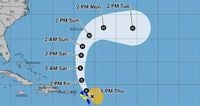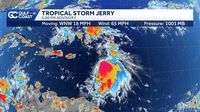Tropical Storm Jerry is making headlines across the Atlantic this week as it barrels toward the northern Leeward Islands, with forecasters warning that the storm could soon strengthen into a hurricane. As of Thursday, October 9, 2025, Jerry had sustained winds of 65 mph and was located roughly 350 miles east-southeast of the northern Leeward Islands, according to advisories from the National Hurricane Center and reports from CNN, USA TODAY, and Gulf Coast News.
Jerry, which formed on Tuesday, October 7, is the 10th named storm of a notably late-blooming Atlantic hurricane season. The season, which runs from June 1 through November 30, has seen a burst of activity in recent weeks, with three hurricanes—Gabrielle, Humberto, and Imelda—forming in just over two weeks to end September. This sudden ramp-up followed a quiet stretch after Hurricane Erin's rapid intensification in mid-August. Now, all eyes are on Jerry as it gathers strength and approaches the Caribbean.
On Thursday, meteorologists from the Gulf Coast Storm Team reported that Jerry was moving west-northwest at about 18 to 20 mph. The storm's speed and surrounding environmental conditions initially prevented rapid strengthening, but forecasters expect Jerry to slow down and intensify, likely becoming a hurricane by late Friday or Saturday, October 10 or 11. "Gradual strengthening is expected during the next few days, with Jerry possibly becoming a hurricane by late Friday or Saturday," the National Hurricane Center stated, as cited by USA TODAY.
A tropical storm warning was issued Thursday for Barbuda and Guadeloupe, while a watch remained in effect for most of the Leeward Islands. The storm is forecast to pass near or just northeast of these islands later Thursday into Friday, bringing the threat of heavy rain, strong winds, and dangerous surf. Jerry is expected to deliver 2 to 4 inches of rain across the Leeward and Virgin Islands, with local maximums reaching up to 6 inches in some areas. Eastern Puerto Rico could see 1 to 2 inches of rain, raising concerns about flash flooding and minor inundation in vulnerable spots.
Swells generated by Jerry began reaching the Leeward and Windward Islands Thursday night and are expected to spread westward toward the Virgin Islands and Puerto Rico, then onward to the Greater Antilles in the coming days. These swells will likely produce life-threatening surf and rip current conditions, a risk that authorities have urged residents and visitors to take seriously. The National Hurricane Center warned, "These swells are expected to cause life-threatening surf and rip current conditions."
Despite the storm's intensity and its proximity to the Caribbean, Jerry is not expected to pose a threat to the mainland United States. A cold front sweeping off the East Coast is forecast to deflect Jerry out to sea, sparing the U.S. from direct impacts. As CNN explained, such cold fronts become more common in October and often serve as a protective barrier against Atlantic storms. "For the U.S., this is not a concern. This is going to be a hurricane by Saturday morning. But watch as this pulls north and stays offshore," meteorologist Lauren Hope told Gulf Coast News viewers.
Still, the risk to the Leeward Islands, Virgin Islands, and Puerto Rico remains significant. In addition to heavy rainfall and potential flooding, gusty winds could cause power outages and minor structural damage in exposed areas. The National Hurricane Center's forecast track suggests Jerry will curve northward after skirting the northern Leeward Islands, keeping its strongest winds and rain offshore for most land areas. However, the center cautioned that the exact path can shift, and impacts may be felt outside the forecast cone.
Meanwhile, meteorologists are keeping a close eye on the broader Atlantic basin. A non-tropical area of low pressure in the northern Atlantic could acquire tropical or subtropical characteristics in the coming days, but the environment is expected to become less favorable for development as it encounters cooler waters and higher wind shear. Additionally, a weather pattern known as the Central American Gyre may develop by mid-October around the western Caribbean. This broad area of stormy weather is notorious for spawning late-season storms, and while it's too early to tell if it will produce a cyclone this year, experts like Phil Klotzbach of Colorado State University say it's worth monitoring closely.
Historically, late-season storms have demonstrated their capacity for destruction. The last few years have illustrated how hurricane activity can ebb and flow: seven named storms formed during October and November last season, while just two did in 2023. Yet, even in quieter years, late-blooming hurricanes can be devastating. Hurricane Michael in 2018 became the latest Category 5 hurricane to make landfall in the U.S. when it struck the Florida Panhandle on October 10. Hurricane Matthew in 2016 and the infamous Hurricane Sandy in 2012 also wreaked havoc in October, underscoring the need for vigilance deep into the season.
Remarkably, the 2025 season has yet to see a hurricane make landfall in the United States. If this streak continues through November 30, it would mark the first hurricane landfall-free season for the U.S. in a decade, a statistic that is both reassuring and unusual given recent years. As CNN noted, "No hurricanes have made US landfall this season. If that luck continues through the end of November, it would be the first hurricane landfall-free season in a decade."
With several weeks left in hurricane season, officials and meteorologists urge residents in hurricane-prone regions to stay prepared. The National Oceanic and Atmospheric Administration (NOAA) recommends developing evacuation plans, assembling disaster supplies, checking insurance coverage, and creating family communication strategies. Strengthening homes—by trimming trees, installing storm shutters, and sealing outside wall openings—can also reduce risks. As NOAA advises, "Get your disaster supplies while the shelves are still stocked, and get that insurance checkup early, as flood insurance requires a 30-day waiting period."
For now, as Jerry churns across the Atlantic, the focus remains on the Leeward and Virgin Islands, Puerto Rico, and the wider Caribbean. Residents are urged to heed warnings, monitor updates, and take all necessary precautions. The unpredictable nature of hurricanes means that even as the U.S. mainland escapes direct impact this time, the threat to island communities is very real. With late-season patterns still unfolding and the memory of past October storms fresh in mind, the 2025 Atlantic hurricane season continues to demand attention and respect from all who live in its path.
As the week closes, Jerry's progress will be closely monitored by meteorologists, local officials, and residents alike—each hoping for a safe passage as the Atlantic's turbulent season rolls on.

